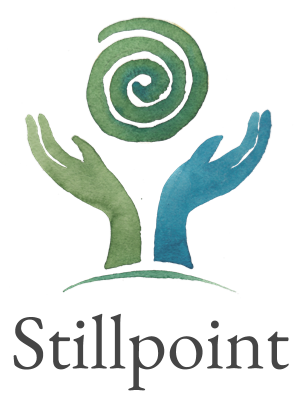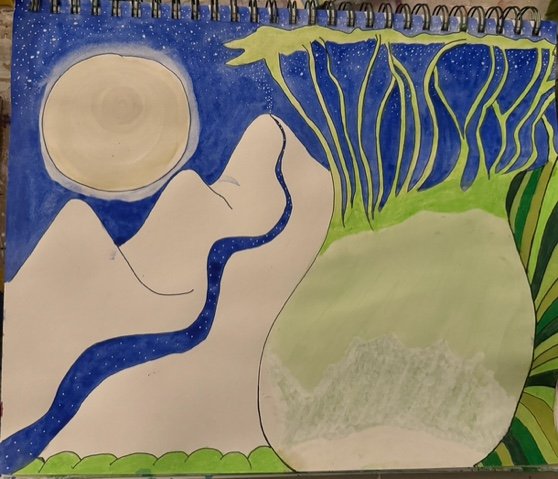Another Way to Listen: Engaging in Contemplative Creativity
By Chantel Zimmerman,
Group Spiritual Direction Offering Leader
As a spiritual director I invite people to connect with and deeply listen for God, Self and their inner artist. The merging of these components results in what is known as “Contemplative Creativity”, a practice that I offer in both group and individual spiritual direction sessions as well as something I do personally.
When we deeply listen and involve ourselves in creative expression we are in a state of contemplative flow. Perhaps you’ve heard of “Flow” - “the state in which people are so involved in an activity that nothing else seems to matter...” (Mihaly Csikszentmihalyi).
Flow states change our brain waves:
The Synctuition website says,
“During flow, the brain shifts from beta waves (fast-moving states of consciousness) to the slower frequencies of alpha and theta. Alpha waves are associated with daydreaming — when we jump from one idea to the next without much resistance. Meanwhile, theta waves show up during REM or just before we fall asleep...”
According to the Center for Action and Contemplation, studies on meditative and contemplative practices suggest that they too induce changes in brain patterns (to alpha and theta).
Are we in a flow state while deeply listening during a spiritual direction session? Many spiritual directors and directees might say that the most important practice in Spiritual direction is listening; listening for God, listening to Self, and listening to and with others. Listening, like being creative, requires noticing, paying attention, and a willingness to let go of expectations and anticipation of what’s coming next. We invite God into the room and allow ourselves to receive what we need. We often think of listening as something that happens with our ears and maybe our hearts. Rarely, if ever, would we expect to hear someone say they listen with their eyes and hands (or bodies); bioenergetics being an exception. However, we would be remiss in failing to include our eyes and hands as doers of the listening. This type of listening is a key component to the spiritual practice of contemplative creativity.
Perhaps as you read the word “creativity” you shy away or shut down. Maybe your first thought is “I am not an artist, or creative” and therefore you fail to entertain the possibility, nay your ability, to engage in contemplative creativity. What if we omitted “art” or “being an artist” from the concept of creativity? What if we broadened the sense of what being creative means to include things like: the stylish outfit your put together today, the delicious meal you cooked last night, the flair with which you decorate your home, and so on? Would you think of yourself as “creative” then? If you did consider yourself creative (because of broadening the word’s meaning) could you then speculate that you might also be artistically creative? Julia Cameron, author of the seminal book “The Artist’s Way: A Spiritual Path to Higher Creativity” suggests that “everyone is creative”. I concur, and just because we are all creative does not mean we need to don the label “artist” to practice contemplative creativity.
Let me share a taste of contemplative creativity in action:
On your morning walk you notice a delightful, purple, summer flower. The vibrant purple draws you in with a sense of wonder and awe at the magnificence of God’s creation. Later that day, during a spiritual direction session, you are reminded of your experience with the flower. Your spiritual director asks if you would like to capture the feeling tone of this vibrant purple in a more permanent way. You say, “yes” and are offered magazines and scissors. Your spiritual director invites you to cut out whatever images replicate the experience of the purple inspiration. You cut and glue down images. As you do this you are relaxed, perhaps even in a flow state. You are connecting with yourself and God through your hands and eyes to something that beckons you. I like to believe this “something” is a message from God, a “God wink”, so to speak. As you work with the images you are reminded of a beautiful sunset-sky filled with pinks, yellows and oranges; you add these colors. There comes a point in the process when you “know” it is complete, that whatever needed to be revealed has arrived; there is a sense of “ahh”. Looking at your image you feel peace. You created something simple that speaks through your physical body and senses – not anything with intention or with a purpose in mind other than to express your earlier experience. This is contemplative creativity.
Taking a deeper dive:
Your Spiritual director invites you to be with this piece and asks, “is there something more” or maybe she says, “what else?”. You begin to explore more deeply by sitting with your collage, lovingly gazing at it, listening with your eyes to discover associations and meaning hidden within. You decide to journal with this display of color, asking the imagery, “What do you have to tell me?” or “Why did you show up in my world today?” or “What meaning do you want to share?”. This is contemplative creativity, and this is not the only way to engage in contemplative creativity. You might take your art piece into the labyrinth, engaging your body (another “ear”) as you meander the twists and turns that unfold as you walk; you listen to what the piece says while you move along. You could let this piece sit on your mantle and every morning journal with it, inviting it to share more with you. The opportunities for spiritual awareness through contemplative creativity are many; your imagination is your limit.
We don’t need to be artists to listen with our eyes and hands, we simply need to allow our eyes to listen to the world around them and engage our hands with what we “hear”. We can respond to color, shape, line, form, image, nature, etc. and then investigate the significance and revelation they divulge. With a little willingness we can express ourselves creatively in response to what we “hear” when we look deeply. We follow this inspiration by engaging our hands in the creation of something authentic and heart centered. When we listen in this way, we begin to hear something different, something from within and outside ourselves, something from Spirit – I like to think that Spirit attracts our eyes and attunes our hands so that we gain spiritual insight and wisdom veiled in the simplicity of listening with another “ear”. Humbly listening to what we are drawn to while remaining curious and open and then responding through painting, drawing, collaging, singing, dancing, etc. can serve as an act of contemplative creativity suffused in deep listening.
Trust that there is a message for you; expand your sense of what “listening” means.
-Chantel
*All art used by permission from Chantel
Through her company, Art and Soul Lab, Chantel invites people to nurture their nature by tapping into their inner wisdom, changing their relationship with their spiritual practice, and building the resilience necessary to act on big dreams. With 20+ years of experience facilitating workshops, classes and retreats, Chantel has come to recognize how contemplative practices support individuals on their personal journey; she often uses the labyrinth as a mediative tool for transformation. Chantel practices deep listening with clients and groups, incorporates the use of transformative arts for self-discovery, and offers healing experiences that promote well-being. Participants gain insight through times of transition, grief, and positive life changes.





